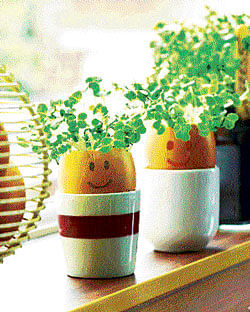
We all crave for time and space where we can shed our guard and just relax in a sanctuary that heals and soothes our senses. Our gardens play a vital supporting role, helping us get some respite from the pressures and chaos of the outside world and bring a sense of personal fulfillment.
Whether they are Zen gardens or Monastic Cloister gardens, throughout history gardens have played important role in healing.
The idea behind healing gardens is to create a therapeutic environment that provides a gentle stimulation of senses and act as a sanctuary. The considerations made while designing a healing garden are the same as any other garden; however these considerations take on a special meaning in healing environments.
Working with nature is central to a healing garden. It is important to keep the design
simple without much going on so that it is easy to understand and maintain. At the same time the garden should be full of sensory experiences. Lot of variety in terms of form, texture, colour, seasonal interest and scent will wake up the senses and create a new appreciation for the garden as well as nature.
Texture and foliage
Plant trees with interesting bark textures, either smooth or self patterned. Choose plants for their interesting foliage, delicate feathery ones like fennel or smooth and bold like magnolia. Ornamental grasses are full of drama specially when light falls on them and their leaves and flowers dance in breeze.
Plant the daintiest of flowers that invoke a feeling to protect or as bold and open as sunflowers. You can’t resist touching the petals of poppy or play with the snapdragons. Let the seasonal changes in the garden bring awareness to the transience in all life forms and awaken the spirit.
Get into the garden at every opportunity, day or night, and look for changes. Notice the effect of light, change in colours, sprouting of seeds, blooming of buds and fading of flowers, unfurling of new leaves and drop of old ones. This dimension of time is unique to the art of garden design and separates it from any other art form.
Sound adds a wonderful aspect. Try to keep intrusive noises to minimal. Use water features or wind chimes for calming effect or to mask the undesirable sounds. Choice of hardscaping should be subtle and not conflict with the needs of the user. Keep a balance so that the space feels stable as a whole. Make the transitions between spaces smooth. Lay out paths clearly. Do not forget to create focal points.
Create various spaces for different activities. Provide areas for varying degree of sun and shade. Make comfortable and suitable seating available.
You may choose to go with the theme of wildlife garden. Plant to attract butterflies or birds - nectar producing flowering plants for butterflies and berry producing fruit trees for birds. Keep birdbaths and bird feeders to encourage winged visitors.
Keep low maintenance fish in a pond. Watching them swim can be very relaxing. Going with edible garden theme can be benefiting in more than one way.
Not only cultivating edibles for the family will bring you satisfaction but also consuming fresh and organically grown produce will taste better. Design plant beds to grow personal favourite varieties surrounded by herb borders, interspersed with splashes of flowering plants.
Colours play a key role
Use colours for healing since they have strong associations with our feelings and memories. Choose red for vitality, orange to bring joy and optimism, yellow for the feelings of self worth and lifting depression, green for harmony, restfulness and relaxation, blue to encourage tranquility and contemplation, and violet to learn to love yourself. Do not neglect the role of aromatic plants in healing gardens. Aromas from carnation, citrus, eucalyptus, jasmine can be stimulating while rose, basil, lavender can be balancing. Cedarwood, juniper, mimosa are relaxing whereas chamomile, jasmine, rose, citrus work as anti-depressants too. Plant combinations can also be made for varying degree of fragrance desired in the garden.
Healing gardens have found special place in hospitals across the developed world. For the old age people, patients of psychiatry, cancer and alzheimer’s, and patients in rehabilitation centers the healing garden also provides horticultural therapy. This therapy may help them regain confidence. It works as a place where they can feel less pain, safe and to some level be healed by nature’s healing process. For old people, patients, physically challenged or people with limited mobility garden made in raised beds at wheelchair height become most functional. Plan to make their participation in garden easier. When living with limitations growing and harvesting bring a sense of fulfillment and achievement. Certain plants may have special meanings to them – use those. Design to engage senses beyond sight. Choose insect and disease resistant varieties to minimize pesticide use and discourage undesirable insects.
(The writer is a landscape designer.)